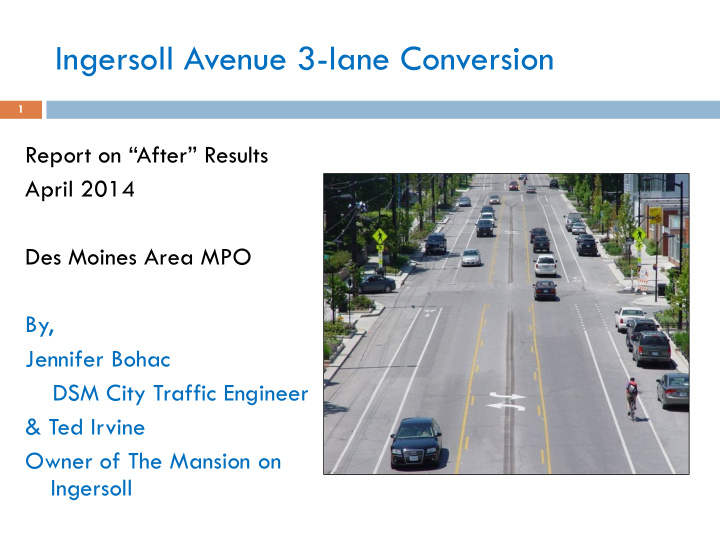



Ingersoll Avenue 3-lane Conversion 1 Report on “After” Results April 2014 Des Moines Area MPO By, Jennifer Bohac DSM City Traffic Engineer & Ted Irvine Owner of The Mansion on Ingersoll
Ingersoll Avenue 3-lane Conversion 2 Project History and 1) Details Safety Aspects 2) Project Process 3) Before – After Analysis 4) Conclusions, Lessons 5) Learned Questions / Comments 6)
Conditions on Ingersoll 3 Very Established Business District, W of CBD Also Trying to “Reinvent Itself” Traffic Conditions 60’ wide Parking on both sides Important bus route Important commuter route 12,000 – 17,000 vehicles per day
Project History 4 2007- 08 – Ingersoll Streetscape Project constructed • 1 st Phase of multi- phase project • 28 th Street to 31 st Street • $3.4 million project • $665,000 (private funds) 2009 3-lane considered
Traffic Study Conclusions 5 Conversion to 3-Lane is Feasible LOS at 31 st Street will be “C” for 3 -lane configuration (current LOS is “B”) Corridor travel time expected to increase slightly 152 total crashes in corridor (2006-2008). 106 are type correctable by TWLTL.
Project Details 6 Ingersoll Ave. is a “Complete Streets” proposal Low-cost project (approximately $15,000 – pavement marking only, no changes in curbs) Ingersoll current traffic volume: 10,000 – 15,000 vehicles per day – (ideal for 3-lane conversion).
Safety Aspects of 3-Lane Roadway 7 • Reduces vehicle speeds • Eliminates passing vehicles • Safer for driver to exit parked cars (wide parking lane) • Improves sight distance – for left turns and driveway exiting traffic • Improves pedestrian and bike safety • 2006 study by Iowa State University of twelve 3-lane conversions showed a 29% reduction in crashes. • Verified by other studies across U.S.
Additional Parking 8 Inadequate parking was identified in the 2004 Ingersoll Ave. Stakeholder Survey as a major item. Approximately 50 on-street parking spaces were added with the 3-lane project
Add Bike Lanes 9 2004 Ingersoll Study called for “Unified, pedestrian - friendly street”. Study further stated “Ingersoll is the logical bicycle link between the downtown and west side neighborhoods and regional trails”. Standard bike lanes could only be accommodated on Ingersoll if the street was reconfigured to 3-lanes.
Implementation Process** 10 Considerable opposition by businesses Council approved Sept. 14, 2009 6-month trial period Before / After evaluation was be conducted “If it isn’t working, we’ll change it back” Implemented May 1, 2010 – by City crews
After Restriping 11
Traffic Conditions 12 No major congestion or delays No significant traffic diversion No increase in traffic crashes No major traffic problems
Traffic Volumes 13 Ingersoll Avenue - 2100 Block Two-way traffic Comparison 1600 1400 1200 Vehicles/Hour 1000 Total Before 800 600 Total After 400 200 0 1 2 3 4 5 6 7 8 9 10 11 12 13 14 15 16 17 18 19 20 21 22 23 24 Time
Traffic Volumes - Daily 14 *2010 = 15,100 ADT at 3400 blk *2012 = 15,900 ADT
Speed and Travel Times (WB) 15 Avg. Speed Travel Time AM Before 25.4 213 After 24.8 220 Change -2% 4% Noon Before 22.9 238 After 22.9 257 Change 0% -1% PM Before 23.8 227 After 21.9 247 Change -8% 9%
16 Final Council approval Oct. 25, 2010 Traffic conditions have generally been as expected, no major problems Crashes reduced 20%, Injury crashes by 30% Survey responses Majority (56%) favor keeping Majority (52%) think it is safer
General Opinion – All Responses 17 Before = 714 After = 1,472
Live or Have Business on Ingersoll 18 Before = 174 After = 175
General Opinion - Safety 19 Before = 713 After = 1,472 33.2%
Have Biked on Ingersoll 20 Before = 287 After = 652
Have Walked Across Ingersoll 21 Before = 538 After = 681
Economic Viability 22 “The goal of traffic calming is to encourage multiple types of transportation (car, bike, walk, and bus) and improve the safety and ‘livability’ of a neighborhood for all users. What sometimes gets overlooked is that safe, pedestrian-friendly neighborhoods are also the types of places where people want to shop, dine-out and own a home . In short, traffic calming improves the economic bottom line for local businesses. ” Source “Livable Streets Coalition”
General Opinion – Business** 23 Before = 711 After = 1,463
Conclusions 24 The data continues to show that the overall Ingersoll Ave Restriping project was successful. Traffic volumes have remained consistent Crashes are still down Private re-investment is taking place in the corridor, In 2012, The Ingersoll and Grand Revitalization Plan was created that expanded the SSMID for these areas Bike counts show around 200 plus bikers per day on the road
Lessons Learned** 25 Public Awareness / Information Many businesses did not know what was proposed – needed more proactive information Relied too much on local “committee” Thought project history guaranteed support Cultivate Support There will be opposition, so need supporters “Sell” as Providing a Complete Street Avoid “Bike Lanes vs. Businesses” Provide Clear, Objective Information and data
Ingersoll Avenue 3-lane Conversion 26 Questions and Comments?
Recommend
More recommend